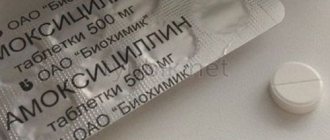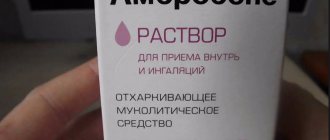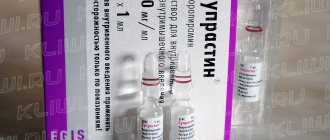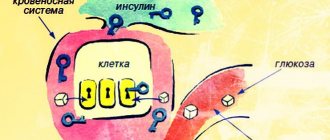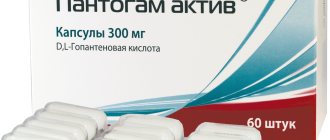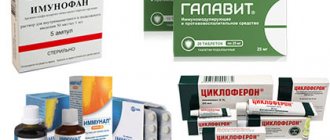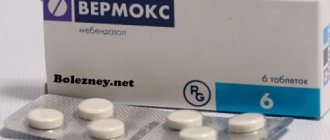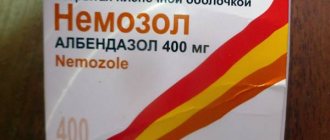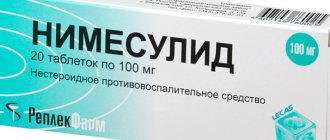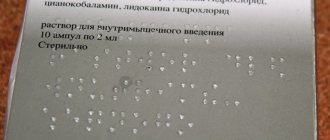Interaction
Inosine pranobex is a drug that has an immunostimulating and antiviral effect.
The direct antiviral effect is associated with the ability of the drug to bind to the ribosomes of virus-infected cells, while the direct antiviral activity is due to its ability to increase the production of its own interferon. Thanks to this, the drug helps the body cope with viral infections.
The immunomodulatory effect makes it possible to increase the production and increase the functional activity of NK cells. These are natural killer cells that attack viruses from the first hours of the disease, and inosine pranobex enhances this effect.
The use of Isoprinosine helps to reduce the clinical manifestations of viral diseases, accelerate convalescence, and increase the body's resistance.
The effectiveness of the drug decreases when taking immunosuppressants simultaneously.
Caution should be used when prescribing the drug with xanthine oxidase inhibitors or agents that promote the excretion of uric acid, including diuretics.
Immunostimulating, antiviral.
According to WHO recommendations, side effects of Isoprinosine are classified as “common” with a frequency of occurrence from 1% to 10% and “sometimes” with a frequency of occurrence from 0.1% to 1%. Also, the side effects of the drug are divided into groups according to their effect on various organs and systems of the human body.
Gastrointestinal organs:
- often - pain in the epigastric region, nausea, vomiting.
- sometimes - constipation or diarrhea.
Liver and bile ducts:
- often - an increase in the activity of alkaline phosphatase and transaminases in the blood plasma, as well as an increase in urea content.
Nervous system:
- often - headaches, weakness, dizziness.
- sometimes – sleep disturbances (drowsiness or insomnia).
Musculoskeletal system:
- often - exacerbation of gout, joint pain.
Uricosuric drugs (including diuretics), as well as xanthine oxidase inhibitors, increase the risk of increased serum uric acid concentrations during therapy with Isoprinosine.
Immunosuppressants reduce the effectiveness of Isoprinosine.
Immunosuppressants reduce the therapeutic effect of Isoprinosine. The simultaneous use of other antiviral agents, for example, interferon alpha, Acyclovir and Zidovudine, enhances the antiviral effect. Also, the simultaneous use of Isoprinosine with Zidovudine lengthens the half-life of the latter. Therefore, a dose adjustment of Zidovudine may be required.
Diuretics (furosemide and other loop diuretics), as well as aspirin, increase the concentration of uric acid and increase the risk of gout when used together with the drug. For the same reason, the use of Isoprinosine in combination with xanthine oxidase inhibitors (Allopurinol) is not recommended.
Drug interactions
According to the instructions, simultaneous use with immunosuppressants or glucocorticoids may lead to a decrease in the effectiveness of Isoprinosine. Xanthine oxidase inhibitors, diuretics, and uricosurics increase the risk of increasing the concentration of uric acid in the blood serum when combined with the drug in question. During therapy with tablets, you should not drink alcohol. Ethanol has a detrimental effect on the immune system and neutralizes the effectiveness of the medication.
Article on the topic: How to take a test for thyroid hormones - preparation rules
Pharmacokinetics
Isoprinosine is a complex purine derivative of synthetic origin and exhibits an immunostimulating effect and also has nonspecific antiviral effects.
The use of Isoprinosine leads to the restoration of lymphocytic function during the period of immunosuppression, increases blastogenesis in a number of monocytic cells, activates the expression of membrane receptors located on the surface of T-helper cells, prevents a decrease in the activity of lymphocyte cells when exposed to glucocorticoids, and normalizes the interpolation of thymidine in them.
Inosine Pranobex stimulates the activity of natural killer cells and cytotoxic T-lymphocytes, activates the functions of T-helpers and T-suppressors, increases the production of immunoglobulin G, interleukins IL-1 and IL-2, interferon-gamma, reduces the production of pro-inflammatory cytokines - IL-4 and IL -10, enhances the chemotaxis of macrophages, monocytes and neutrophils.
Isoprinosine in vivo has antiviral activity against Herpes simplex viruses (herpes), measles virus, cytomegalovirus, influenza A and B, human T-cell lymphoma virus type III, human enterocytopathogenic virus, polioviruses, as well as equine encephalitis and encephalomyocarditis.
The antiviral effects of the drug are associated with inhibition of viral RNA and the enzyme dihydropteroate synthetase, which is involved in the synthesis of some viruses. The drug also stimulates the replication of lymphocyte mRNA previously suppressed by viruses, which results in inhibition of the RNA biosynthesis of the virus itself and a decrease in the biosynthesis of viral proteins, increases the production of alpha and gamma interferons, which exhibit an antiviral effect.
When used in combination, it enhances the effectiveness of interferon-alpha, as well as the antiviral drugs Zidovudine and Acyclovir.
After oral administration, it is well and fairly quickly absorbed from the gastrointestinal tract.
Cmax in blood plasma is observed after 1-2 hours.
It is rapidly metabolized to form uric acid and is excreted in the urine.
No accumulation of the drug in the body was detected.
The half-life for the two metabolites is 3.5 hours and 50 minutes.
Complete elimination of the drug Isoprinosine from the patient’s body occurs after 24-48 hours.
We suggest you familiarize yourself with Herpes under the nose quick treatment - Facial care
After oral administration, Isoprinosine is quickly absorbed into the blood from the gastrointestinal tract in almost full volume (90%). The bioavailability of the drug is also high. The maximum concentration in the blood is observed after 1 hour. When taking 1500 mg of the drug, the concentration after 1 hour will be 600 mcg/ml. Isoprinosine is also eliminated from the body quite quickly, since 2 hours after administration it cannot be detected in the blood. The process of metabolizing the drug begins. Almost all metabolites of Isoprinosine appear in the urine 8-24 hours after administration.
The main metabolite of Isoprinosine is uric acid, which is excreted through the kidneys. However, this may result in the process of acid crystallization, which should be taken into account when prescribing the drug to patients with urolithiasis. There is no accumulation of active and auxiliary substances in tissues.
Acetamidobenzoic acid is metabolized to o-acyl glucuronide, N,N-dimethylamino-2-propanol is metabolized to N-oxide. The half-life of acetamidobenzoic acid metabolites is 50 minutes, the N,N-dimethylamino-2-propanol metabolite is 5 hours. Complete elimination of all drug metabolites from the body occurs within 1-2 days.
How to take Isoprinosine
The tablets are taken orally with water. Time of administration: after meals. The dosage of Isoprinosine in accordance with the instructions is determined the same for children from three years of age (weight from 20 kg) and adults: per 1 kg of weight - 50 mg of the drug per day. The total prescribed dose of the drug can be divided into three to four doses. In severe forms of disease, the daily dosage can be doubled according to the doctor’s decision (taken for 4-6 trips).
Article on the topic: Estradiol in men - normal, increased and decreased values
The duration of therapy depends on the characteristics and course of the disease:
- Treatment of acute forms of the disease in children and adults takes from 5 days to two weeks. The end of treatment is determined by the disappearance of symptoms. After which the therapy continues for another two days.
- For chronic diseases (recurrent), therapy is divided into several courses lasting 5–10 days each. The pause between courses is 8 days.
- When prescribing maintenance therapy, a dose of 0.5-1 g per day is prescribed, duration is one month.
Treatment of herpetic infection involves taking tablets for 5–10 days until all symptoms are eliminated. Then, for preventive purposes, therapy continues for an additional 30 days, 1000 mg daily (in two doses). For human papillomavirus, the daily dose for adult patients is 6 tablets. Dosage regimen: two tablets three times a day and half a tablet (3-4 times) per 5 kg of weight - in children over three years old. Monotherapy lasts 14–28 days.
A similar treatment regimen for human papillomavirus is recommended for eliminating genital warts. A course of monotherapy can be combined with surgical methods for removing formations. Duration – the same 14–28 days. Then it is recommended to repeat the course of treatment three times with monthly breaks. The instructions recommend undergoing a routine examination by a doctor between courses.
According to the instructions for the treatment of cervical diseases, the daily dosage is six tablets, two pieces at a time. The course of treatment is 10 days. In total, you need to take 2-3 such courses with a pause of 10–14 days. Before making a decision, it is necessary to take into account the relatively high cost of Isoprinosine, since it is not advisable to temporarily interrupt or cancel the course of treatment.
Overdose
For adults and children over 1 year of age, the drug is prescribed orally at 50 mg/kg body weight per day, divided into 3-4 doses. The maximum daily dose is 4 g.
The daily dose depends on body weight, the course and severity of the disease, and the patient’s condition.
The duration of treatment is 5-14 days; in severe cases, the duration of treatment can be up to 90 days.
The effect on the ability to drive vehicles or operate other machinery has not been studied.
However, it should be borne in mind that the drug may cause dizziness or other adverse reactions from the nervous system.
No cases of overdose were observed. No data.
In the case of acute viral diseases, the following principle is true: the earlier the use of the drug tablets began, the greater its effectiveness will be.
The dosage of Isoprinosine is calculated individually. For this, only the patient’s weight is taken into account, but the dosage does not depend on age. The optimal daily dosage is 50 mg/kg of weight (or, to make it easier to calculate, 1 tablet per 10 kg of weight). The resulting number should be divided into 3-4 doses.
In some cases, the daily dosage for adults can be doubled by the doctor, up to 100 mg/kg of body weight. The dosage for children should not be increased under any circumstances. If the calculated dosage needs to be rounded to a whole number of tablets, always round down. For example, if the patient's weight is 59 kg, then his total body weight will be 59 * 50 mg or 2950 mg.
Since one tablet contains 500 mg, the dosage will be 2950/500 mg or 5.9 tablets per day. Rounding to the whole (downwards) gives 5 tablets. They can be taken three times a day, according to the 2 2 1 scheme or 4 times a day, according to the 2 1 1 1 scheme. The breaks between doses must be taken evenly - 6 hours for 4 times a day and 8 hours for three times a day.
The maximum daily dosage of the drug for an adult patient is 4 g. In old age, the dosage is not adjusted.
The duration of treatment depends on the disease. Diseases for which the duration of treatment is 5-14 days or until clinical symptoms disappear plus two additional days:
- acute ARVI,
- measles,
- flu,
- Infectious mononucleosis.
If you need to continue taking Isoprinosine after two weeks, you should consult a doctor
Diseases for which the course of treatment with the drug is 5-10 days, with a possible repetition of the course after 8 days:
- genital and labial herpes,
- shingles,
- cytomegalovirus infection.
A total of 4-5 short courses of tablets are recommended. Then Isoprinosine can be prescribed in a maintenance dosage - 1-2 tablets per day for a month.
Some doctors propose another scheme, according to which, for relapses of chronic diseases, the drug should be taken until the symptoms completely disappear, and then for another 2 weeks. The following regimen can also be used - after the relapse has passed, Isoprinosine should be taken one tablet per day for a month. And for acute diseases, the drug should be continued for two more days after the symptoms disappear.
For papillomas and genital warts, the duration of treatment is 14-28 days. In addition, the dosage of the medicine in such cases is somewhat different. For patients over 12 years old, it is 2 tablets 3 times a day. For children 3-11 years old, the dosage is calculated according to the standard formula - 1 tablet per 10 kg of weight. A total of three courses are recommended with a break of a month.
When treating papillomas, tablets can be used as monotherapy; for condylomas, either as monotherapy, or in combination with the surgical removal of condylomas.
We invite you to familiarize yourself with the use of flaxseed oil in cosmetics
For cervical dysplasia caused by the papilloma virus, the drug is taken 2 tablets 3 times a day. A total of three courses are required with a break of 10-14 days.
The instructions for Isoprinosine recommend taking the tablets orally (orally) after meals with water.
As a rule, the daily dose of Isoprinosine for adult patients and patients over 3 years old weighing more than 20 kg is 50 mg/kg, in 3-4 doses per day.
Adult patients are prescribed 6-8 tablets per day, children - half a tablet for every 5 kg of weight per day.
If necessary, in severe cases of infectious diseases, the daily dose can be individually increased to 100 mg/kg body weight, in 4-6 doses.
For adult patients, the maximum dose of the drug per day is 3-4 grams.
Instructions for use by children define the maximum daily dose for this age category as 50 mg/kg.
When treating acute diseases, the course of treatment for all age categories continues for 5 to 14 days. After the symptoms of the disease disappear, the pills are continued for another 2 days. If necessary and under the supervision of a physician, the course of therapy can be increased.
For chronic pathologies with relapses, several courses of therapy are prescribed lasting 5-10 days, with an interval of 8 days between courses.
Maintenance therapy can take place with a reduced daily dose of up to 500 mg or 1000 mg (1-2 tablets). The course of treatment is carried out for 30 days.
Herpetic infection requires treatment for 5-10 days until symptoms disappear completely, and continues in the asymptomatic period for another 30 days, at a daily dose of 1000 mg divided into 2 doses (to reduce the risk of possible relapses).
For HPV, the recommended daily dose for adult patients is 6 tablets (2 tablets 3 times a day), and half a tablet for every 5 kg of weight for pediatric patients, in 3-4 doses. Monotherapy continues for 14-28 days.
For genital warts with relapses, the drug is prescribed in the same doses as for HPV. Treatment can be carried out either in monotherapy or in combination with surgical treatment for 14-28 days. In the future, a three-fold repetition of the course of therapy with breaks of 1 month is indicated.
For cervical dysplasia, due to exposure to HPV, the daily dose is 6 tablets in 3 divided doses (2 tablets each). The course of therapy takes 10 days, followed by 2-3 similar courses, with a break of 10-14 days.
The cost of a course of therapy using Isoprinosine will require significant funds, so before carrying out treatment, take a closer look at how much the tablets of this drug cost, so as not to interrupt the therapy process in the future.
Cases of overdose with Isoprinosine have not been described.
Contraindications
The medicine "Isoprinosine" for children is not used for:
- hypersensitivity to the components of the drug;
- chronic renal failure;
- gout;
- urolithiasis;
- arrhythmias.
Also, the drug is not used for children weighing less than 15 kg and under 3 years of age.
Indications for use of Isoprinosine tablets
- therapy for influenza virus and other acute respiratory viral infections;
- infectious diseases that were caused by the herpes virus types 1, 2, 3, 4 and 5 (recently there has been information about the effectiveness in the treatment of herpes type 6, as well as types 7 and 8), labial herpes, genital herpes and herpetic keratitis;
- chickenpox, herpes zoster;
- infectious mononucleosis due to herpes virus type 4 (Epstein-Barr virus);
- measles (in severe cases of the disease);
- cytomegalovirus infection caused by herpes virus type 5;
- molluscum contagiosum;
- human papillomavirus infection (HPV), including papillomas of the vocal cords and larynx, fibrous type;
- The drug is also effective in treating HPV in the genitals of women and men and in therapy for getting rid of warts.
Analogs
Today there are at least two hundred drugs with antiviral properties on the market. Popular analogues of Isoprinosine are presented in the table below.
| Name | Active substance | Peculiarities | Use in children | average price |
| Groprinosin | Inosine pranobex | Has a similar effect (antiviral, immunostimulating) with Isoprinosine | Allowed for children over 3 years old | Tablets, 500 mg (50 pcs.) - 1200 rub. |
| Amiksin | Tiloron | Stimulates the production of interferon, making the body less sensitive to the effects of viruses | Allowed for children over 7 years old | Tablets, 125 mg (10 pcs.) - 900 rub. |
| Cycloferon | Meglumine acridone acetate | Stimulates the production of interferon, has antiviral, immunomodulatory activity | Allowed for children over 5 years old | Tablets, 150 mg (20 pcs.) - 350 rub. |
| Acyclovir | Acyclovir | An antiviral drug with high effectiveness against the herpes simplex virus and the causative agent of chickenpox | Allowed from birth (according to doctor's indications) | Tablets, 400 mg (20 pcs.) - 220 rub. |
| Ingavirin 60 | Vitaglutam | Antiviral, anti-inflammatory drug with high effectiveness against influenza and most ARVI pathogens | Allowed from 13 years old | Capsules, 60 mg (7 pcs.) — 380 rub. |
| Polyoxidonium | Azoximer bromide | An immunomodulatory drug affects the main components of the immune system: it enhances the activity of phagocytes - cells that destroy bacteria, and promotes antibody formation | Allowed for children over 6 (for suppositories) and 12 (for tablets) years | Tablets, 12 mg (10 pcs.) - 600 rub. Suppositories, 12 mg (10 pcs.) - 1000 rub. |
An analogue of Isoprinosine, Ingavirin, is a drug for emergency prevention of acute respiratory viral infections.
Application Features
Isoprinosine tablets contain wheat starch, which may contain gluten. The tablets contain mannitol, which can have a laxative effect.
The syrup contains sucrose. Isoprinosine syrup also contains methylparaben and propylparaben, which can cause allergic reactions. Caution should be exercised when using the syrup in patients on a controlled sodium diet (syrup contains less than 11.95 mg/5 ml sodium).
Isoprinosine - instructions for use, dosage for children and adults, contraindications and reviews
Your personal data is processed on the tiensmed website. If you do not agree with this fact, you should immediately leave this site. If you continue to use the site, this means that you have agreed to the processing of your personal data. The site provides reference information for informational purposes only.
7/18/ · Trimedat – before meals or after? It is optimal to take the tablets 15–30 minutes before meals for both adults and children. If for some reason it is not possible to take Trimedat 15 to 30 minutes before meals, then this.
Side effects
- dizziness, headache, weakness;
- dyspeptic symptoms;
- increased transaminase activity;
- increased levels of uric acid in the blood and urine;
- rash, itching;
- nervousness.
Like most other drugs, Isoprinosine is not always and not all patients tolerated equally well. The most common side effects when taking Isoprinosine are allergic reactions - skin rash, hives, and sometimes swelling. Frequent (more than 1% of cases) side effects of Isoprinosine also include:
- headache,
- dizziness,
- increased fatigue,
- bad feeling,
- loss of appetite,
- nausea,
- vomit,
- pain in the epigastric region.
We invite you to find out what Lokoid ointment is used for
Somewhat less frequently, other adverse reactions may occur when taking the drug:
- Gastrointestinal tract (constipation, diarrhea, vomiting),
- liver and biliary tract (increased activity of transaminases (ALT, AST) and alkaline phosphatase, increased concentration of uric acid in the blood),
- nervous system (nervousness, drowsiness or insomnia).
The following side effects of Isoprinosine cannot be ruled out:
- polyuria (increased amount of urine excreted during the day);
- joint pain;
- exacerbation of gout in patients suffering from this disease;
- systemic allergic reaction - Quincke's edema.
Isoprinosine reviews from doctor
Isoprinosine
Isoprinosine is an immunostimulant with an antiviral effect.
Inosine pranobex, which is part of the composition, activates macrophages, enhances the production of antibodies, T-l, Ig G, interferon gamma, and inhibits viral RNA.
The drug is active against CMV, HSV, influenza virus, ECHO virus, etc.
Presented in tablet form of 500 mg - 20, 30 and 50 tablets.
I prescribe isoprinosine in the complex treatment of genital herpes, PVI, CIN, also after destructive treatment. Isoprinosine is well tolerated, works effectively (provides a significant reduction in HPV HPV titer), long-term remission, and side effects are rare. Monitoring of uric acid, monitoring of liver and kidney function is mandatory. Like any immunostimulant drug, isoprinosine must be taken strictly according to indications.
During gestation, isoprinosine is not recommended due to the lack of studies on the safety of use.
Of the minuses, I can note the high price, availability in rare pharmacy outlets, inconvenient regimen (the need to take 6-8 tablets/day 3-4 times).
Isoprinosine
Isoprinosine is an immunostimulant, thereby having a nonspecific antiviral effect. The annotation for this drug indicates a wide range of antiviral effects.
Manufacturers limit the intake of Isoprinosine by age. Children starting from 3 years old and reaching 15 kg in weight are allowed to take it in the form of syrup.
However, like any thinking doctor, I use this remedy in my pediatric practice with caution. In other words, I approach the prescription of immunostimulants with extreme caution, since a fragile immune system can react in an unpredictable way.
In other words, I cannot dispute that Isoprinosine is effective and quite high, but prescribing/using it for therapy for any respiratory viral disease in a child is dangerous.
The approach to treatment with Isoprinosine should be selective.
Isoprinosine is a drug with questionable safety and effectiveness
Isoprinosine (INN Inosine Pranobex) is presented on the pharmaceutical market as an immunostimulating drug. This drug was synthesized in the USA in the 70s. This drug was developed primarily as an antiviral drug, but in the process of studying the mechanisms of Isoprinosine, immunostimulating activity was revealed.
However, despite the fact that this drug is undergoing some clinical trials for the treatment of certain viral diseases, it is not included in the standards of treatment. In particular, a number of studies confirm the “effectiveness” of Isoprinosine in the treatment of HPV - however, today it has been proven that HPV can be independently eliminated from the body within 1-2 years - without any treatment. And in this case, is it worth trusting Isoprinosine and spending a sufficient amount of money, by and large, “in vain.”
Moreover, the safety of this drug is in some cases seriously questioned, so it is not advisable to use it at all.
This drug is contraindicated for use in pregnant and lactating women. And despite the fact that the instructions indicate that it can be used in children from the age of three, I would not use it, again due to the lack of information about the safety of this drug.
Other information
After 2 weeks of therapy with Isoprinosine, it is necessary to conduct studies on the content of uric acid in urine and blood serum.
When carrying out long-term treatment (more than 4 weeks), it is recommended to monitor kidney and liver functions (transaminase activity, creatinine level, uric acid content) every month.
It is necessary to monitor the level of uric acid in the blood when using Isoprinosine in combination with drugs that increase its level, as well as with drugs that impair renal function.
Since Isoprinosine causes an increase in the concentration of uric acid in the blood, during the course of treatment with Isoprinosine the concentration of uric acid in the blood and urine should be determined once every two weeks. It is also necessary to do this procedure after the end of treatment. This is especially true in cases where the patient additionally takes drugs that increase the concentration of uric acid in the blood.
Also, every month you should monitor possible changes in the leukocyte formula, liver enzymes, and creatinine levels in the blood.
The tablets cannot be taken during pregnancy and breastfeeding, since their safety during these periods has not been studied.
It is recommended to take the tablets after meals, without chewing and with plenty of water.
Cases of overdose of Isoprinosine have never been recorded.
There are no instructions in this regard in the instructions. On the one hand, Isoprinosine does not directly affect the nervous system, however, on the other hand, side effects such as drowsiness and dizziness are possible when taking the drug. Therefore, during the course of treatment, persons driving vehicles and performing work that requires concentration should consult a doctor.
Analogues of Isoprinosine, list of drugs
- Allokin-Alpha;
- Amiksin;
- Amizon;
- Arbidol;
- Lavomax;
- Panavir;
- Kagocel;
- Proteflazid, etc.
Important - instructions for use of Isoprinosine, price and reviews do not apply to analogues and cannot be used as a guide to the use of drugs of similar composition or action. All therapeutic prescriptions must be made by a doctor. When replacing Isoprinosine with an analogue, it is important to consult a specialist; you may need to change the course of therapy, dosages, etc. Do not self-medicate!
Synonyms
The main synonym for Isoprinosine is the drug Groprinosin, which also contains the active substance.
If there are existing problems with the immune system and for the indications described above, the attending physician may prescribe Groprinosin or Isoprinosin. Only an immunologist can decide which of these medications is best to take in a particular case.
It can be noted that the dosage regimen of the drug Groprinosin is more gentle, and therefore it is more often prescribed for the treatment of children and elderly patients.
Release form and composition
The composition of 1 tablet of the drug Isoprinosine includes 500 mg of inosine pranobex (isoprinosine) - the active substance.
Additionally, the tablet contains:
- 10 mg – povidone;
- 67 mg – wheat starch;
- 67 mg – mannitol;
- 6 mg – magnesium stearate.
The drug Isoprinosine is available in the form of biconvex, oblong tablets, white or similar in color, with a score line on one side.
One package contains 20, 30 or 50 tablets.
Isoprinosine and also groprinosin are produced in tablets of 20, 30 and 50 tablets in one package. Although in Russian pharmacies today you can buy a small plate (blister) of 10 pieces. The pharmacist simply takes the package, separates the blisters and sells the buyer one blister containing exactly 10 tablets of the drug. At the same time, there is no need to buy the entire package at once, the price of which is high.
Composition: active ingredient – inosine pranobex. The weight of one tablet is 500 mg.
Analogs
Tablets 1 tablet.
active substance:
inosine pranobex 500 mg
excipients: mannitol; wheat starch; povidone; magnesium stearate
Tablets: oblong, biconvex, white or almost white, with a slight amine odor, scored on one side.
Isoprinosine is produced in the form of tablets that contain 500 mg of inosine pranobex. Additional components include povidone, wheat starch, magnesium stearate and mannitol.
These are white oblong tablets, which contain 10 pieces. in a blister. The cardboard package may contain 5, 3 or 2 blisters.
With alcohol
When carrying out the prevention and treatment of diseases of viral etiology, you should not combine Isoprinosine and alcohol.
Drinking alcohol, especially in large quantities, has a detrimental effect on the human immune system; therefore, the compatibility of drugs to enhance immunity with alcohol will, at best, lead to the neutralization of mutually exclusive effects.
Isoprinosine is not compatible with alcohol. With the simultaneous use of Isoprinosine with ethanol, the patient may experience side effects such as renal colic, arrhythmia, renal failure, pyelonephritis, and allergic reactions. Isoprinosine also affects the liver, and its combination with alcohol can lead to jaundice, stagnation of bile in the liver and hepatitis.
The increase in interferon production caused by the drug leads to the fact that interferon contributes to increased alcohol toxicity. As a result, the patient may develop psychopathology, depression and other central nervous system dysfunctions. Therefore, during treatment with the drug, you should avoid consuming alcoholic beverages, even in small doses.
Russian analogues of the drug
Cheap analogues of the drug groprinosin are easy to find on the pharmaceutical market. You can choose high-quality and inexpensive substitutes from domestic manufacturers, as well as from other countries.
Russian-made synonyms are discussed in more detail in the table below.
Name of the drug
Average price in rubles
Characteristic
Anaferon
200–250
An analogue of groprinosin with antiviral action. Contains antibodies to human interferon. Release form: white tablets. Effective in the treatment of diseases of viral origin.
Arbidol
350–400
High-quality substitute for groprinosin. The active substance umefinovir actively fights the development of viruses. The medicine is used to treat respiratory diseases. Contraindications: hypersensitivity, children under 3 years of age.
Hyporamine
100–150
Cheap synonym for the drug. The main substance is sea buckthorn leaf extract
An antiviral immunostimulant, effective for the treatment of influenza, acute respiratory viral infections, and viral infections. Use with caution during pregnancy and breastfeeding, prohibited in case of individual intolerance.
Ingavirin
400–450
An effective analogue of groprinosin with an anti-inflammatory effect. The main substance imidazolylethanamide quickly relieves the symptoms of infection. It has a number of contraindications: pregnancy, breastfeeding, allergic reactions, children, adolescents under 18 years of age.
Tiloron
500–630
A good analogue of groprinosin with a high ability to enhance immunity. It is used in the treatment of various viral diseases.
Flavoside
80–100
The best cheap analogue of groprinosin produced in the form of syrup
The main substance is proteflazide, obtained from an extract of plants of turf pike and ground reed grass. It is used in the treatment of herpes, chicken pox, influenza, ARVI, mononucleosis, hepatitis, AIDS.
Composition and use of the drug
The drug Isoprinosine is available in the form of oblong tablets. One package can contain from 20 to 50 tablets. The active component of the drug is inosine pranobex, which is a substance of animal origin. Due to the main component, biochemical reactions in the body are enhanced, due to which the following occurs:
- the activity of the immune cells of the human body increases;
- interferon production increases;
- the chain of formation of microorganisms is disrupted, the production of enzymes that activate viruses is blocked.
It is necessary to take Isoprinosine tablets for a certain time, following the instructions or medical recommendations. Its negative effect on the presence of pathogenic microorganisms due to the improvement of protective functions has been noticed. In addition to the treatment of papillomas and warts caused by HPV, the drug is prescribed as a treatment for:
- influenza, ARVI;
- herpetic infection, including herpes zoster, herpetic keratitis, genital herpes, chickenpox;
- molluscum contagiosum;
- cytomegalovirus infection;
- measles
The drug Isoprinosine is prescribed in combination with other drugs, including antiviral drugs. It should be prescribed exclusively by a doctor, since the dosage of the drug is selected individually for each person, as is the treatment regimen.
Expert opinion
Sakania Luiza Ruslanovna
Dermatovenerologist, cosmetologist, trichologist
Ask a Question
There are contraindications to the use of the drug, as a result of which it is replaced with a drug that is suitable in action, but different in composition. Isoprinosine does not accumulate in the body. Its withdrawal is carried out over the next 48 hours, after reaching the maximum concentration in the blood.
The substance of the drug Isoprinosine is absorbed through the gastrointestinal tract, maximally manifesting itself in the blood plasma 2 hours after administration. It is excreted from the body through the kidneys and other urinary organs without any residue. Today, this remedy is one of the most effective in the fight against HPV, which can be detected even in young children.
The drug Isoprinosine helps strengthen the immune system, so that papillomas and warts do not grow, but gradually disappear. Acting on viruses from the inside, the product fights their external manifestations. Thus, the herpes virus, which often recurs in many people, can be sent into a long-term stage of remission.
In people with weak immunity, warts on the body can appear up to 5 times in 1 year. They spoil the aesthetic appearance of the skin, and when injured, they contribute to infection.
Long-term recurrent HPV can lead to serious complications, including malignant cell division. Taking Isoprinosine along with interferon according to the regimen, you can significantly increase the resistance of the immune system to various viruses.
Reviews
Reviews about this drug are very different, and sometimes diametrically opposed. Some parents speak positively about the medicine; they believe that the medicine normalized the child’s condition and quickly got him back on his feet.
Others complain that the medicine not only did not help, but even had a negative effect on the liver. There are a lot of complaints about the high cost and form of the drug. Parents find the tablets very inconvenient and difficult for children to swallow.
Doctors' opinions also vary. Some doctors consider the medicine highly effective, others - absolutely useless. We only note that the Russian Academy of Medical Sciences classifies Isoprinosine as an outdated drug with unproven effectiveness.
At what age can a child take it?
This medicine should be taken only as prescribed by a doctor. Pediatricians prescribe this medicine in tablet form for children from the age of three.
However, it is strictly forbidden to give these tablets to children who weigh less than 15 kg. It is contraindicated to give this medicine in any form to babies under one year old, and from one to three - only in the form of syrup. So, you can take Isoprinosine:
- for children from 1 to 3 years old - in the form of syrup;
- children from the age of three (3 years and older) with a child weighing more than 15 kilograms.
Contraindications and overdose of the drug
Isoprinosine is contraindicated for use in a number of diseases due to the threat of worsening the patient's condition.
This is due to the fact that the drug in the process of metabolism increases the load on the kidneys and liver, which can cause disruptions in the rhythm of the heart and its functioning. Diseases and conditions for which the drug should not be taken:
- Urolithiasis disease. The main active ingredient during excretion promotes increased formation of sparingly soluble acid and salts, which can cause serious complications in the functioning of the urinary system.
- Gout. Excess uric acid can lead to severe forms of the disease.
- Arrhythmia.
- Chronic liver and kidney failure. Due to the breakdown products of the active substance of the drug, the load on these vital organs increases.
- Hypersensitivity to the components of the drug. This is an absolute indication for cancellation.
Many of these diseases can be asymptomatic, so before treating HPV with Isoprinosine, it is necessary to identify disturbances in the body’s functioning. Many people begin to take medication for papillomas on their own, after which they suffer from negative reactions and consequences.
There are no officially registered cases of overdose. Reviews do not contain information about this phenomenon. Theoretically, a drug taken in an excessive dosage can cause an increase in the concentration of uric acid in the urine and blood. Therapy is aimed at eliminating symptoms.
Side effects
If the patient, for one reason or another, does not adhere to the recommendations of the drug manufacturer and doctor regarding the use of Isoprinosine, he will encounter the side effects that this drug gives. During treatment, the patient may be bothered by the following types of ailments:
- Pain in the epigastric region;
- Increased uric acid levels in the blood;
- Increased alkaline phosphatase activity;
- Disorders of the stomach and intestines;
- Attacks of nausea and vomiting;
- Itching sensation on the skin;
- Headache;
- Severe weakness in the body;
- Dizziness;
- Joint pain;
- Increased frequency of urination;
- Exacerbation of gout.
Expert opinion
Sakania Luiza Ruslanovna
Dermatovenerologist, cosmetologist, trichologist
Ask a Question
Side effects are unlikely to bother a person who takes the drug at the prescribed dose. Their prerequisites may be conditions in which treatment with Isoprinosine is strictly prohibited. So, careful study of the list of contraindications will also help to avoid negative reactions from the body.
In most cases, Isoprinosine is well accepted by the patient’s body. Side effects occur only in rare cases. Taking the medication for too long can increase the likelihood of developing negative reactions.
